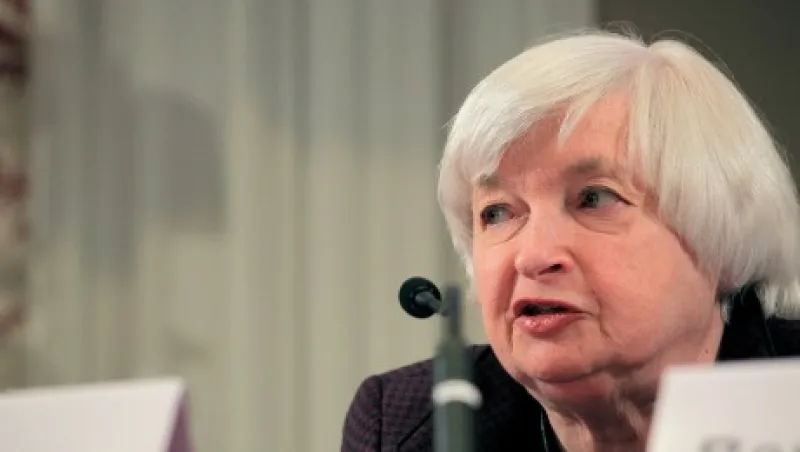Much of the speculation in fixed income this morning is that the Federal Open Market Committee may finally drop the phrase “considerable time” from its language at its meeting today as growth projections are raised and markets prepare for a rate increase next year. Also on deck for the day are U.S. consumer price inflation figures for November, which are expected to register a marginal contraction for the month. Despite these expectations, yields on ten-year Treasuries continue to remain near multimonth lows, as global events drive a flight to safety. In a report issued yesterday, Gluskin Sheff market strategist David Rosenberg compared current global volatility to the 1997–’98 Asian financial crisis, when oil prices fell by more than 50 percent on weak demand forecasts and the U.S. dollar rose by nearly 20 percent against a trade-weighted basket. Rosenberg notes that during the period, “You would have thought we had a U.S. recession on our hands but we didn’t.” At that time, U.S. GDP averaged above 4 percent and unemployment declined despite global deflationary fears. For now at least, all data seems to indicate that the U.S. will also shrug of the current volatility in emerging markets as well.
Russia unable to stem ruble slide. After two days of double-digit percentage declines against the dollar and other benchmark currencies, the Russian ruble staged a temporary rebound today as Russia’s Finance Ministry liquidated foreign reserves. The rise proved short lived however, as the currency continues to exhibit extreme volatility. Yesterday multiple U.S. brokerages suspended trading in the ruble for clients as primary dealer banks withdrew from making markets.
Japanese exports disappoint. November trade data for Japan released today by the Ministry of Finance included export levels well below consensus forecasts at 4.9 percent year-over-year growth. A key challenge facing policymakers in the nation is soft external demand despite a weakened yen, as trading partners including China and Europe struggle to prop up growth.
No change in course for the Bank of England. Minutes from the Bank of England’s Monetary Policy Committee December 3 policy meeting released today revealed a 7-2 vote to keep benchmark interest rates at a record low as the bank’s leaders see positive growth signals as unlikely to drive inflation in the near term. The language in the release largely mirrored that of the November meeting.
FedEx Corp. releases earnings. Memphis–based shipping company FedEx Corp. announced earnings for the second quarter of fiscal 2015 at 7:30 am U.S. Eastern time. At $2.14 per share, the results were 36 percent higher than the same period last year, but well below analyst forecasts, which estimated share prices to exceed $2.20. FedEx announced two significant acquisitions this week, logistics provider Genco and international e-commerce services firm Bongo International.
Portfolio Perspective: The Outlook for U.S. Treasuries — Francis Scotland, Brandywine Global
In November The Wall Street Journal reported that 47 out of 47 economists expect higher bond yields by the end of 2015. The U.S. economy is probably growing near 3 percent and inflation is hovering between 1 and 1.5 percent. Nominal gross domestic product growth, therefore, is more than 4 percent. It is easy to conclude that the conditions for a pent-up bear market are there, even though contrary opinion argues it won’t happen anytime soon.
The most likely explanation for this situation is that the U.S. is importing significant deflationary pressure from the rest of the world via a strong dollar.
In Germany, the five-year break-even inflation rate has collapsed to zero. This is Europe’s strongest economy and by far, its most competitive. Yet the downward convulsion in inflation expectations underscores the total failure of European monetary policy to avert deflation. No matter what European Central Bank president Mario Draghi says he is going to do about the central bank’s balance sheet, he still hasn’t done it. Russia’s conflict with the Ukraine and Western sanctions have only made things worse.
China’s authorities want to transform the nation from a mercantilist manufacturing export machine to a consumer-driven service economy. But efforts to shed excess capacity in manufacturing, along with too successful a campaign to deflate the property sector and purge corruption, have ended up in deflation. Producer price inflation in China has been negative for nearly three years and U.S. import prices from Asia are falling. The authorities have started to lean in the other direction but it will take a lot of effort to turn momentum in this economic ship.
Lastly, there are the emerging markets. Many have been raising rates since former Fed Chairman Bernanke’s famous taper tantrum talk. Fear of a 1990s-style emerging-markets crisis has provoked belt tightening and inflation fighting at a time of depressed demand around the world. Balance of payments for the Fragile Five are improving because of lower domestic absorption. No one is picking up the slack. The result is weak commodity prices, a global surplus of savings and a glut of capital.
Capital markets act as regulators of growth. Strength in the dollar and deflationary pressure abroad, therefore, are forcing the U.S. bond market to act as the counterweight in order to prop up the domestic economy. Reflationary policy from abroad is by far the most important development to watch for in terms of timing an end to the current bull run in U.S. Treasuries.
Francis Scotland is the director of global macro research at Brandywine Global, an asset management firm is a wholly owned, independently operated subsidiary of Legg Mason, headquartered in Philadelphia.






